
The newly redesigned 2024 Hyundai Santa Fe is something to talk about in that it is no longer a vehicle that fades into the background as the previous generations did so well to fit into the vanilla culture of suburbia. For the redesign, Hyundai took some cues from their EV lineup, among other unique design aesthetics, for a new boxy and chiseled structure that plays well to turn heads. While I do love the front and side profile look of the new Santa Fe, the rear end still has some growing to do as it doesn’t quite fit the cute appeal that I get head-on or from a front and side angle profile.
Apart from the new design boxy and pixel-themed design, the new Santa Fe has matured in ways I didn’t think Hyundai would dare go where such a vehicle may encroach on buyers who cross-shop the slightly larger Hyundai Palisade and other midsized crossovers. There’s a lot of newness of the Santa Fe to like and welcome with wide open arms in its uniqueness, bountiful list of features in the loaded-up Calligraphy trim, unique Earthy Brass Matte paint on my test vehicle, and a well-to-do driving character. Admittedly, there are many design traits that somewhat imitate the design of modern Range Rovers in more ways than one, which isn’t necessarily a bad thing.

Returning for the newly redesigned 2024 model year is an engine that I praised in a previous review of the Santa Fe, which is also found in the performance trims of the Hyundai Sonata N-Line and its Kia K5 GT platform cousin. The engine, a turbocharged 2.5-liter inline-4-cylinder, is good for 277 horsepower and 311 lb-ft of torque mated to an 8-speed automated dual-clutch transmission. The powertrain feels at home in the Santa Fe, and best of all, it comes as standard equipment, starting the Santa Fe off in its base SE trim form as an attractive offering. Long gone is the underwhelming naturally aspirated 4-cylinder, giving way for the larger redesigned Santa Fe to be a better competitor in its highly competitive crossover segment. With the 277-horsepower engine the Santa Fe AWD can scoot to 60 mph in about 6.7 seconds.
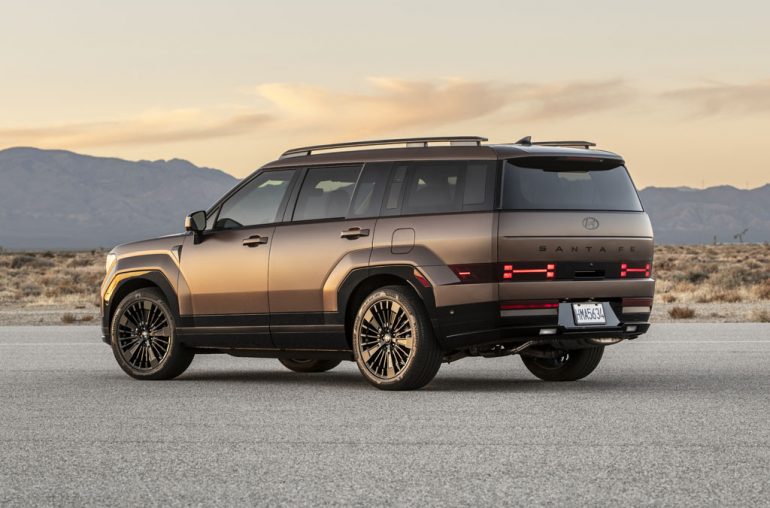
Power from the turbocharged engine is good but does suffer from a taste of lag out of the hole. However, the dual-clutch automated 8-speed transmission does well to slip its computer-controlled clutch to get things moving but still finds some clunkiness to contend with in having such a setup. In most cases, the transmission feels like a traditional automatic that has a torque converter. However, the shifting transitions at lower speeds still prove to be an area that the dual-clutch just can’t smooth out like a traditional automatic would. Still, this iteration of the dual-clutch is among the smoothest I’ve experienced in a Hyundai vehicle.
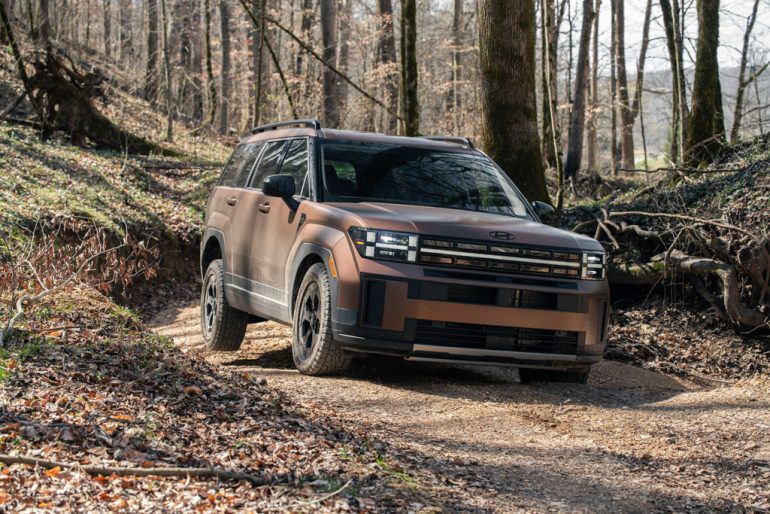
Hyundai Santa Fe XRT trim
The ride quality and overall adaptation of the new Santa Fe to different road surfaces is excellent, even with the larger 21-inch wheels on my Calligraphy trim test vehicle. The all-wheel-drive system proves to be a welcoming feature when aggressively powering out of turns where the front-wheel-drive bias doesn’t senselessly spin the front wheels where traction control would normally step in. There’s also a nice balance of the new Santa Fe on the road, which feels more planted and stable at highway speeds over the outgoing generation.

The new 2024 Hyundai Santa Fe now has just two powertrain choices: the turbocharged 2.5-liter 4-cylinder with its 8-speed automated dual-clutch transmission or a hybrid setup utilizing a 1.6-liter turbocharged 4-cylinder engine and a single electric motor all mated up to a 6-speed automatic transmission. Of course, as you expect, the hybrid setup gets much better EPA numbers at 36 mpg city and 35 mpg highway. The Santa Fe with the gas engine, which comes is offered in five trim levels (SE, SEL, XRT, Limited, Calligraphy), gets respectable numbers starting at 20 mpg city, 29 mpg highway, and 24 mpg combined for the standard FWD models. Move to the AWD trims, apart from the XRT off-roading trim (19 mpg city/26 mpg highway), and you’ll settle on getting 20 mpg city, 28 mpg highway, and 23 mpg combined, which was attainable in the real world driving my Santa Fe Calligraphy test vehicle.
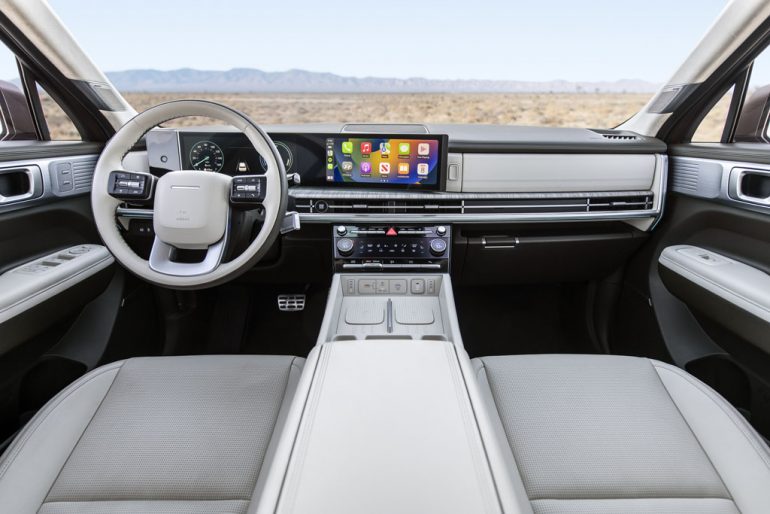
The cabin of the newly redesigned 2024 Santa Fe takes a new approach to things, which is a good thing considering how well everything flows and is easy to reach. There’s a lot of forward-thinking involved in how well the interior of the new Santa Fe is laid out. The seating areas have plentiful space with good travel in their adjustments, as well as heating and ventilation up front and heating in the second-row captain’s chairs.
The second row of seats has a good amount of room, while the third row proves to be usable for two adults in finding a decent space for short trips. The compromise in the third row is mostly the cargo room behind it when it is up in place. You only have 14.6 cubic feet of space, which is something to keep in mind if you ever need to travel with the third row up in place. However, placing the third-row seatbacks down will give you just over 40 cubic feet of storage accessed by the smart power liftgate.

As far as technology, Hyundai moves the envelope forward with its latest pair of 12.3-inch screens on the dashboard encased in a curved enclosure. The digital gauge cluster is kept mostly simple and plays down on the colorfulness of previous iterations of Hyundai’s clusters but retains the unique function of displaying a blind-spot camera display upon enabling the turn signal. The infotainment touchscreen portion of the setup is updated, with more of a monotoned look to the graphics, but it keeps a tradition of being straightforward in its user-friendliness.
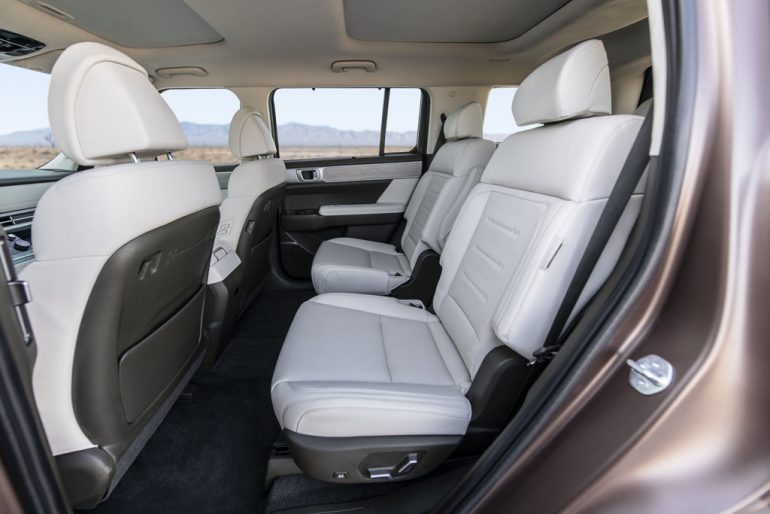
There’s wireless (or USB-connected) Apple CarPlay and Android Auto integration, which combines rather cleverly designed dual wireless charging pads that are some of the best form-fitting pads for modern smartphones. There’s also a clever user of how you connect to the USB ports, providing a selection to connect data either through a port or combined charging. Lastly, there’s a nifty method of cleansing your smartphone: you can close the upper glove box storage area and then enable a UV-C sterilization function that uses UV light to sterilize small items.

To expand on storage and convenience, there are plenty large and deep pockets on the door trim, in addition to clever front floor storage and access functions for the front center armrest storage area that can be accessed by second-row passengers. There’s a lot to like in the interior thoughtfulness and tech packed into the new Santa Fe, including one useful exterior feature of having unique grab handles in the C pillars for standing on the rear tire to access the roof rails.

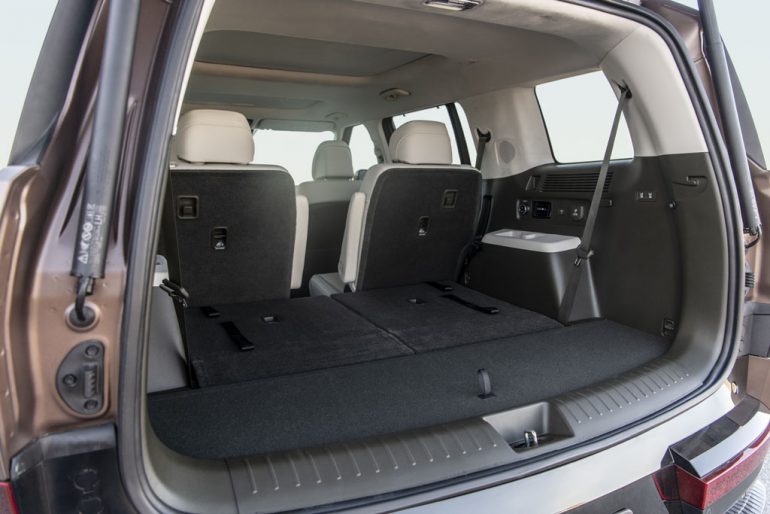
The new 2024 Hyundai Santa Fe includes all of the expected active safety features found in modern day vehicles but adds a little extra by the way of its clever and unique blind-spot camera system. Other highlights include forward collision avoidance assist, blind-spot warning with rear cross-traffic assist, lane-keeping assist with lane following assist, full-speed adaptive cruise control, Highway Driving Assist 2, report smart parking assist, and a 360-degree camera system with a live 3D view. The 2024 Hyundai Santa Fe also received the Top Safety Pick award from the IIHS.

The new 2024 Hyundai Santa Fe in its base SE trim starts at $33,950, and with its five trim levels, there’s something for everyone as you step into upper trims, including more premium features. At the top end of the trim scale, my Hyundai Santa Fe Calligraphy AWD test vehicle comes to a total of $50,905, which includes the optional floor mats ($210), Matte paint ($1,000), and an inland and freight charge of $1,395.

Malcolm Hogan is the founder and editor of Automotive Addicts, a trusted voice in the automotive media world for over two decades. With 20+ years of hands-on experience covering the industry, Malcolm has built a reputation for delivering honest reviews, sharp insights, and in-depth coverage of everything from new car debuts to high-performance test drives. Passionate about the evolving car culture and staying ahead of the curve, Malcolm continues to lead Automotive Addicts as a go-to destination for enthusiasts and industry insiders alike.